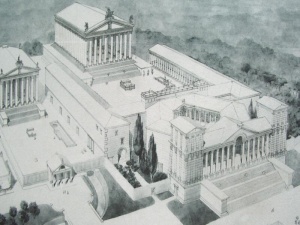Temple of Jupiter

The temple of Jupiter was first constructed around 509 B.C.E. which coincided with the overthrow of the Tarquinian kings. It was built more as an Etruscan designed but it became the heart of the Roman Republic depending on voluntary donations at first.
It would include sections for Juno and Minerva but Jupiter was the Roman equivalent to the Greek Zeus. Those three representations of a divine God was known as the Capitoline Triad, which were significant to the Roman state religion.
The Temple of Jupiter Optimus Maximus was a standard religion, but religion was not just what people thought about a god or gods. The gods represented virtues like courage and caring and religion was how a scattered tribe created the social bonds that kept them together in hard times.
From its earliest times, it was a repository for objects that reminded them of their culture as a people. Rituals were a way of reminding them of the courage and sacrifice needed to overcome hard times or fight battles that meant surviving as a free people. They built their culture, which gave their generation an understanding of their struggles and sacrifices of historical significance.
Jupiter was seen as a great protecting deity of the people with distinct moral conception which eroded over time. Jupiter was especially concerned with oaths, treaties, and leagues, and it was in the presence of his priest that the most ancient and sacred form of marriage were performed.
Julius Caesar was Flamen Dialis (high priest of Jupiter) in his early career.[1]. When he fell out with Sulla during a civil war he went into the military. His uncle Marius had reformed the army so that the spoils of war could finance the welfare state that was growing in Rome thanks to its many temples.
It was a repository of writings and public records, of political importance, military exploits, and religious sacrifice. The Sibylline Oracles containing the prophecy of the Sibyls, copies of laws, agreements and treaties, were kept at the site, which was also a meeting place for the senate. It and all it contained were a physical symbol of Roman supremacy and divine mandate.
It was destroyed and rebuilt numerous times until a form of Christianity introduced by Constantine replace their original public religion. With this new state religion, the public funds for the upkeep of the temple were diverted by the emperor Theodosius in 392 C.E.
Banking links
Federal Reserve |
Money |
Money Audio |
Real Money |
Money can be anything |
Commodity money |
Mammon |
One purse |
Knife |
Corban |
Altars |
Golden calf |
Reserve fund |
The Bank of the Golden Calf |
Graven images |
Temples Banks and the Brokerage House |
Temples |
Temples and Churches |
The Greatest Reset |
Ephesus |
Temple of Diana |
Temples of Herod |
Federal Reserve |
Bretton Woods Institutions |
Temple in Jerusalem |
Moneychangers |
Seven men |
Tithe |
Treasury |
Surety |
Imperial Cult of Rome |
Babylon |
New Deal |
Section 666 |
Mark of the Beast |
If you need help:
- Or want to help others:
Join The Living Network of The Companies of Ten
The Living Network |
Join Local group |
About |
Purpose |
Guidelines |
Network Removal
Contact Minister |
Fractal Network |
Audacity of Hope |
Network Links
Footnotes
- ↑ The Flamen Dialis(Diespiter was the Old Latin form of the name Jupiter) was officially ranked second in the ranking of the highest Roman priests in the ordo sacerdotum (between the Rex Sacrorum and the Flamen Martialis, Flamen Quirinalis) and Pontifex maximus. He would be emancipated from the control of his father, and became sui juris.